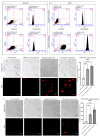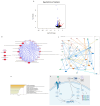Synthesis and Biological Evaluation of Herceptin-Conjugated Liposomes Loaded with Lipocalin-2 siRNA for the Treatment of Inflammatory Breast Cancer
- PMID: 40732340
- PMCID: PMC12299312
- DOI: 10.3390/ph18071053
Synthesis and Biological Evaluation of Herceptin-Conjugated Liposomes Loaded with Lipocalin-2 siRNA for the Treatment of Inflammatory Breast Cancer
Abstract
Background: Inflammatory breast cancer (IBC) is a rare and aggressive subtype of breast cancer that accounts for 1-5% of BC patients and regularly affects women under 40 years of age. Approximately 50% of IBC cases are HER2+ and can be treated with the monoclonal antibody-based therapy Herceptin (trastuzumab). However, resistance to Herceptin develops within a year, and effective second-line targeted therapies are currently unavailable for IBC patients. Lipocalin-2 (LCN2) is a promising therapeutic target for IBC due to its role in promoting tumor invasiveness, angiogenesis, and the inflammatory tumor microenvironment characteristic of IBC. Objective: We developed Herceptin-conjugated liposomes loaded with LCN2-targeted small-interference RNA (siRNA) for HER2+ IBCs. Methods: We synthesized DSPE-PEG(2000)-maleimide-Herceptin in a three-step process and formulated the liposomes together with DOPC, PEG(2000)-PE, cholesterol, and siRNA. Results: Dynamic light scattering confirmed the liposome size distribution, which was 66.7 nm for the Herceptin-conjugated liposome versus 43.0 nm in a non-functionalized liposome. Here, we report efficient internalization of this formulation into HER2+ IBC cells, reducing LCN2 levels by 30% and disrupting tumor emboli formation. RNA sequencing revealed 139 genes that were differentially expressed upon LCN2 knockdown, with 25 canonical pathways identified through Ingenuity Pathway Analysis. Conclusions: These findings suggest that LCN2-targeted siRNA within Herceptin-targeted liposomes represents a promising therapeutic strategy for IBC.
Keywords: inflammatory breast cancer; lipocalin-2; liposomes; siRNA; tumor emboli.
Conflict of interest statement
The authors declare no conflicts of interest.
Figures








Similar articles
-
Single-cell transcriptome analysis reveals the malignant characteristics of tumour cells and the immunosuppressive landscape in HER2-positive inflammatory breast cancer.J Exp Clin Cancer Res. 2025 Jul 8;44(1):196. doi: 10.1186/s13046-025-03454-z. J Exp Clin Cancer Res. 2025. PMID: 40624675 Free PMC article.
-
Cost-effectiveness of using prognostic information to select women with breast cancer for adjuvant systemic therapy.Health Technol Assess. 2006 Sep;10(34):iii-iv, ix-xi, 1-204. doi: 10.3310/hta10340. Health Technol Assess. 2006. PMID: 16959170
-
Multiscale Modeling Uncovers Macrophage Infiltration and TNF-α Signaling Networks for Targeting in Inflammatory Breast Cancer Tumor Emboli.bioRxiv [Preprint]. 2025 Aug 12:2025.05.29.656249. doi: 10.1101/2025.05.29.656249. bioRxiv. 2025. PMID: 40502021 Free PMC article. Preprint.
-
Topotecan, pegylated liposomal doxorubicin hydrochloride and paclitaxel for second-line or subsequent treatment of advanced ovarian cancer: a systematic review and economic evaluation.Health Technol Assess. 2006 Mar;10(9):1-132. iii-iv. doi: 10.3310/hta10090. Health Technol Assess. 2006. PMID: 16545208
-
Systemic treatments for metastatic cutaneous melanoma.Cochrane Database Syst Rev. 2018 Feb 6;2(2):CD011123. doi: 10.1002/14651858.CD011123.pub2. Cochrane Database Syst Rev. 2018. PMID: 29405038 Free PMC article.
References
-
- Chippa V., Barazi H. StatPearls[Internet] StatPearls Publishing; Treasure Island, FL, USA: 2023. [(accessed on 31 January 2025)]. Inflammatory Breast Cancer. Available online: https://www.ncbi.nlm.nih.gov/books/NBK564324/ - PubMed
-
- De Schepper M., Nguyen H.-L., Richard F., Rosias L., Lerebours F., Vion R., Clatot F., Berghian A., Maetens M., Leduc S., et al. Treatment Response, Tumor Infiltrating Lymphocytes and Clinical Outcomes in Inflammatory Breast Cancer–Treated with Neoadjuvant Systemic Therapy. Cancer Res. Commun. 2024;4:186–199. doi: 10.1158/2767-9764.CRC-23-0285. - DOI - PMC - PubMed
-
- National Cancer Institute Cancer Stat Facts: Female Breast Cancer. [(accessed on 28 March 2025)]; Available online: https://seer.cancer.gov/statfacts/html/breast.html.
Grants and funding
LinkOut - more resources
Full Text Sources
Research Materials
Miscellaneous

